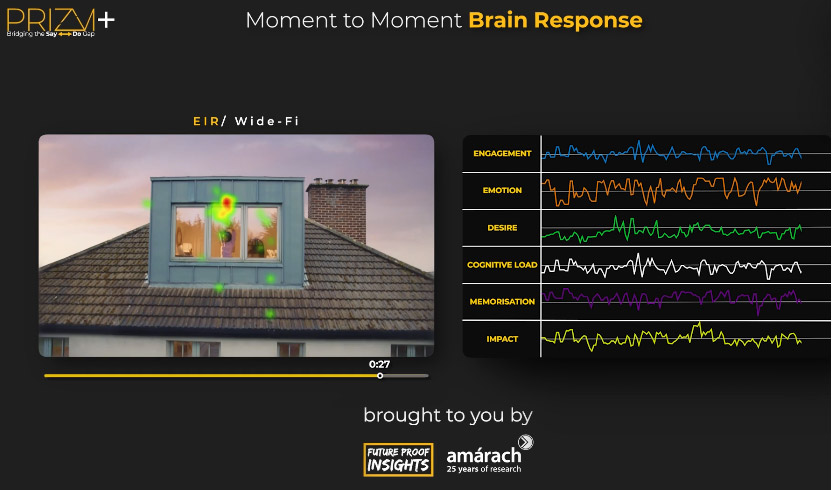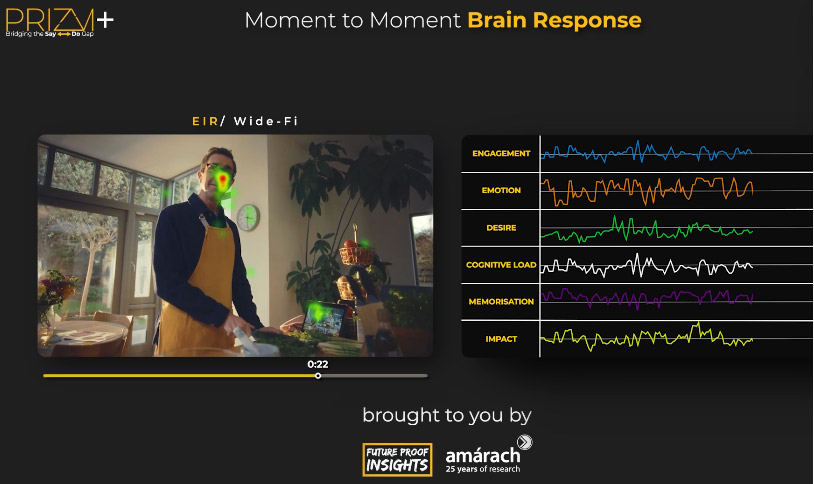Every week, Amárach and Future Proof Insights share exclusive findings from their PRIZM+ ad testing service, showcasing best practice creative advertising in Ireland.
Eir’s “Wide-Fi” campaign tackles a modern frustration that almost every household can relate to: too many people using too little bandwidth.
It dramatises the problem through a clever spatial metaphor, walls literally expanding as connectivity improves, and aims to resolve everyday tech tension with a sense of calm, control and space.
From a strategic perspective, the creative leans into family realism while visually elevating the emotional benefit of better broadband.
The transformation from a cramped, noisy living room into a peaceful, spacious home is immediate and easy to follow. This is not about abstract tech specs, it’s about creating a better home environment.
Our EEG analysis shows the ad performs well overall, particularly in how it builds emotional momentum. Early scenes trigger recognisable tension, while later sequences unlock positive emotion and a feeling of resolution.
Engagement levels stay strong throughout, while memorability peaks at key product and brand moments. Importantly, cognitive load never overwhelms, even during more metaphor-heavy transitions. This means viewers remained mentally involved, not confused.
Desire was steady rather than explosive, understandable for a category like broadband where the benefits are more functional than emotional. But the visual storytelling, particularly moments where family members enjoy relaxed, independent screen time, helps turn functionality into aspiration.
With the high-level picture in place, we break down the scenes that worked best and those that fell flat.
High-Impact #1: Scene 4 (6.8–12.2s) — Visual Expansion & Product Reveal
This is the creative turning point. Just as the stress builds, the house begins to expand. Light floods in, space opens up, and the router is shown in a clean, modern cutaway. The narrator’s line, “Widen your WiFi with new Eir Wide-Fi,” lands just as the transformation begins.
Why it worked: This is a classic example of emotional and narrative payoff arriving at the same time. The viewer has been primed by discomfort, and this is the release. The brain likes resolution, and here, the story, product and VO all align to deliver one. It’s also the first proper branding moment, which means the emotional high gets tied directly to Eir.
Neuro signals spike: engagement and memorisation surge, while cognitive load falls back into the optimal range. A perfect blend of narrative relief and brand priming.

High-Impact #2: Scene 8 (23.6–26.4s) — Aerial Household & Brand Tagline
This wide, clean aerial view of the home serves as the visual full stop on the ad. The VO says, “Eir. For all.” The message is simple, the brand is clear, and the emotional tone is calm and assured.
Why it worked: By this point, the audience has seen the problem, the transformation, and the benefit. This moment ties it all together. The camera movement creates a feeling of space and satisfaction in what neuroscientists would describe as reward closure. Viewers associate the brand with that feeling, locking in memorability.
The timing also matters. As one of the final scenes, this benefits from the recency effect, meaning it’s one of the last things people see and are more likely to remember.

Underperforming #1: Scene 2 (2.1–4.5s) — Family Frustration Montage
Here we see the individual pain points: the son’s frustration, mum’s shushing, dad and teen glaring at stalled devices. The problem is clearly illustrated but it doesn’t hit as hard as it should.
Why it underdelivered: While the frustration is familiar, it lacks a cohesive build-up. There’s no strong emotional cue to bind these reactions together, which weakens the brain’s ability to make sense of what it’s seeing. The audience recognises the issue but doesn’t yet care. From a brain point of view, there’s noise but no signal, no emotional lift, no desire, no resolution.

Underperforming #2: Scene 6 (15.8–22.1s) — Father Streaming in Kitchen
This moment was designed to show the benefit in action: a dad watching a cooking tutorial, smiling while chopping veg. It’s a lifestyle cue, but it doesn’t hit the mark.
Why it underdelivered: Functionally, the scene makes sense. But emotionally, it doesn’t land. The father’s actions are routine, and there’s no drama, no reward, no visual twist. There’s nothing here for the brain to latch onto. Engagement drops slightly, and memorisation remains flat. It’s technically competent but creatively neutral.

Behavioural Impact and Demographic Highlights
Behaviourally, the ad did what it needed to do. Motivation was strongest, viewers understood what was on offer and wanted it, especially those who could empathise with the chaos in the opening scenes. The idea of regaining control in the home is clearly resonant.
Capability scored well too. The product benefit is clear and easy to grasp: better, more consistent broadband across the home.
Where it lagged slightly was Opportunity. Because each family member is shown having a better time alone, the ad missed the chance to suggest broader social or family-level benefits. In behavioural terms, it didn’t build a strong sense of shared experience or social proof.
Demographically, the message landed best with younger families and parents with kids. This is the very audience most likely to relate to device-heavy households. Older adults and non-parents showed less interest, lower emotional scores and weaker recall, suggesting the core message didn’t stretch beyond the target group.
Final Thought: Lessons for Marketers
There’s a lot to admire in how Eir delivered this campaign. It’s grounded, relatable and visually well-executed. Where it works best is in timing: putting the brand in moments of emotional payoff, rather than tacking it on at the end. When the story and product resolve at the same time, the brain pays attention.
The creative team also made smart choices in how they used space and light to represent emotional states, something more advertisers could benefit from. But a few scenes could have worked harder. Adding emotional colour to functional tasks, or showing the benefit in a more social context, would help push this even further.
For future campaigns, anchor your product in the moments when your audience feels most relieved, most hopeful, or most seen. That’s where memory lives. That’s where persuasion happens.
For more insights from PRIZM+ on how neuroscience drives advertising impact, visit: https://www.futureproofinsights.ie/prizm-plus/.
(Pic: YouTube/Eir)









